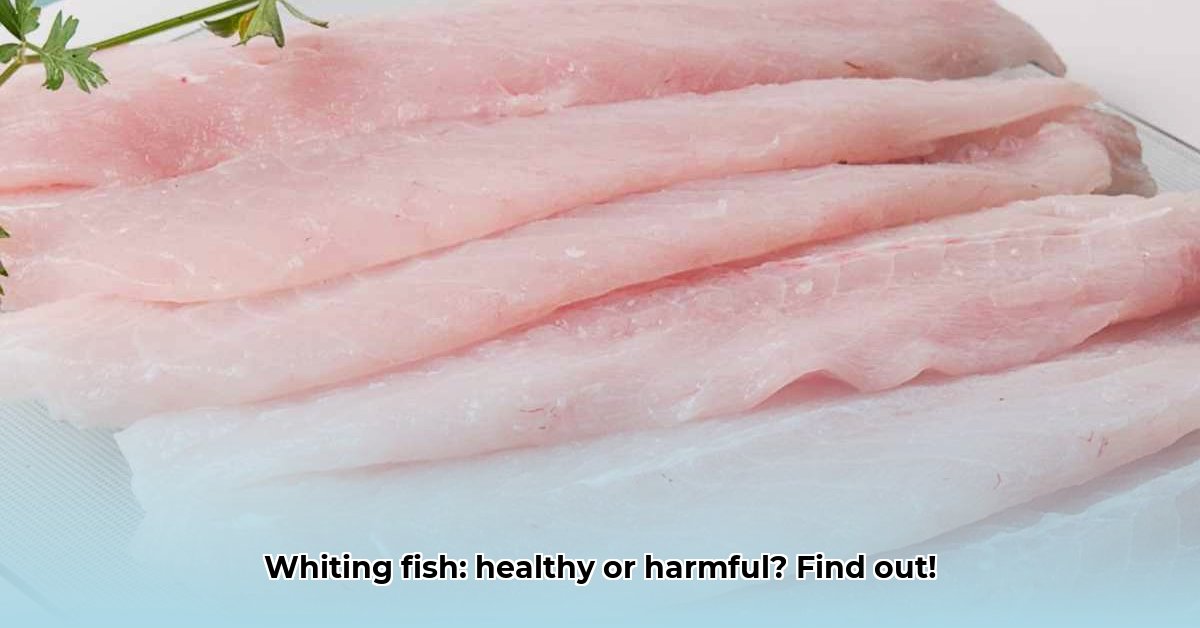Looking for a delicious, affordable, and nutritious seafood option? Whiting fish is an excellent choice! For more in-depth information, check out this comprehensive guide. This comprehensive guide explores the health benefits of whiting, compares it to other popular fish, and offers practical tips for safe preparation and consumption for everyone, including pregnant women and children. Discover how to confidently add this versatile fish to your diet.
The Verdict: Is Whiting Fish Healthy?
Absolutely! Whiting is a fantastic source of lean protein, making it ideal for weight management and muscle building. It’s also packed with essential vitamins and minerals that contribute to overall health and vitality.
Nutritional Breakdown: Unveiling the Benefits
One of whiting’s most notable features is its low-fat content, making it a heart-healthy option. Let’s examine how its nutritional composition stacks up against popular choices like salmon, tuna, and cod:
| Nutrient | Whiting (per 100g) | Salmon (per 100g) | Tuna (per 100g) | Cod (per 100g) |
|---|---|---|---|---|
| Calories | 90 | 208 | 130 | 82 |
| Protein (grams) | 19-24 | 20-25 | 25-30 | 18-22 |
| Fat (grams) | <1 | 13 | 5 | <1 |
| Vitamin B12 (mcg) | High | Moderate | Moderate | Moderate |
| Selenium (mcg) | High | Moderate | Moderate | Moderate |
| Omega-3s (mg) | 200-300 | 2000-2500 | 500-1000 | 100-200 |
| Mercury (ppm) | Low | Low to Moderate | Moderate to High | Low |
(Note: Nutrient values are approximate and can vary based on factors such as fish size, origin, and preparation.)
While whiting may not have the high omega-3 fatty acid levels of salmon or tuna, it’s a great protein source with beneficial nutrients and low mercury levels. The FDA classifies whiting as a “Best Choice” fish, meaning it’s safe to eat two to three servings a week.
Whiting’s Health Perks
Adding whiting to your diet provides several advantages beyond its nutrient profile. Its high-quality protein aids tissue repair and muscle development. B vitamins boost energy levels, while selenium, a powerful antioxidant, protects cells from damage caused by free radicals.
Potential Risks and Precautions
Whiting is generally safe, but it’s good to be aware of a few considerations. Like many fish, whiting can accumulate trace amounts of environmental contaminants such as PCBs (polychlorinated biphenyls) and dioxins. To minimize exposure, buy whiting from reputable sources committed to sustainable fishing practices. Check for certifications from organizations like the Marine Stewardship Council (MSC). As with all foods, moderation is key.
Delicious Ways to Cook Whiting
Whiting’s mild flavor makes it incredibly versatile in the kitchen. You can bake, grill, pan-fry, or poach it! The secret is to avoid overcooking, which can lead to dryness. Gently cooked whiting retains moisture and maximizes its flavor and nutritional benefits. Experiment with different herbs, spices, and marinades to create your favorite dishes! A simple lemon-herb preparation is both light and delicious.
Here’s a basic cooking method:
- Prepare the fillets: Rinse the whiting fillets gently and pat them dry with paper towels.
- Season generously: Sprinkle with salt, pepper, and your favorite herbs (dill, parsley, and thyme are excellent choices).
- Choose your cooking method: Baking, grilling, pan-frying, or poaching all work well. Adjust cooking time based on the thickness of the fillets. Aim for a flaky texture without dryness. A good rule of thumb is 10 minutes per inch of thickness.
- Serve immediately: Enjoy your healthy and tasty whiting!
For baking, preheat your oven to 375°F (190°C). Place the seasoned fillets on a baking sheet lined with parchment paper and bake for 12-15 minutes, or until the fish is cooked through and flakes easily with a fork.
For pan-frying, heat a tablespoon of olive oil in a skillet over medium heat. Add the seasoned fillets and cook for 3-4 minutes per side, or until golden brown and cooked through.
Making Whiting a Regular Part of Your Diet
Is whiting fish a healthy choice? Absolutely! It’s a delicious and nutritious option that can easily be incorporated into a healthy meal plan. By selecting sustainably sourced whiting and preparing it using simple, healthy methods, you’re making smart choices for your well-being. Aim for two to three servings each week as part of a balanced diet.
Whiting vs. Other Fish: A Nutritional Comparison
Whiting is a versatile and affordable white fish often overlooked in favor of tuna and salmon. Let’s investigate how its nutritional content compares to these popular choices.
Detailed Nutritional Profile of Whiting
Whiting is a lean protein source, low in fat, and provides several essential nutrients. It’s naturally rich in Vitamin B12, crucial for nerve function and red blood cell formation. It also contains niacin, a B vitamin that supports healthy energy metabolism, and selenium, a potent antioxidant. Whiting also provides calcium, potassium, vitamin B, magnesium, and phosphorus.
Whiting vs. the Competition: A Nutritional Showdown
| Nutrient | Whiting (3 oz) | Salmon (3 oz) | Tuna (3 oz) | Cod (3 oz) | Tilapia (3 oz) |
|---|---|---|---|---|---|
| Calories | 89 | 175 | 100 | 70 | 109 |
| Protein (grams) | 19 | 17 | 22 | 15 | 22 |
| Fat (grams) | 1 | 10 | 1 | 1 | 2 |
| Vitamin B12 (mcg) | 1.2 | 2.6 | 2.5 | 0.7 | 0.5 |
| Selenium (mcg) | 21 | 26 | 34 | 18 | 16 |
| Omega-3s (mg) | 250 | 1500 | 240 | 100 | 140 |
| Mercury (ppm) | Low | Low-moderate | Moderate | Low | Low |
Note: Values are approximate and can vary based on species, sourcing, and preparation methods.
While whiting may not be as rich in omega-3 fatty acids as salmon or as high in vitamin B12 as tuna, it provides a consistent nutritional profile with a lower mercury content.
Health Benefits of Whiting
Lower mercury levels make whiting a safer option, especially for pregnant women and children.
Potential Risks and Considerations
All fish may contain trace amounts of environmental contaminants. It’s important to select responsibly sourced whiting from reputable vendors. Be aware of potential allergic reactions, although they are less common with whiting than with some shellfish.
Cooking with Whiting
Whiting’s mild flavor makes it highly versatile. It’s delicious baked, grilled, pan-fried, or steamed. Experiment with herbs, spices, and sauces like lemon-dill, garlic-herb, or a spicy Cajun rub.
Key Takeaways:
- Whiting is a lean protein source rich in essential vitamins and minerals.
- It has lower mercury levels than some other popular fish.
- Whiting is an affordable and versatile option.
- Responsible sourcing is important for minimizing environmental concerns.
- Explore different cooking techniques to enjoy its taste and nutritional benefits.
Smart Strategies for Safe Whiting Consumption
Whiting: Is it a healthy and safe addition to your diet? Let’s explore!
Nutritional Value
Whiting is a lean protein source, ideal for those watching their calorie intake. It provides essential vitamins and minerals, but how does it compare to other fish?
| Nutrient | Whiting (per 100g) | Salmon (per 100g) | Tuna (per 100g) | Cod (per 100g) |
|---|---|---|---|---|
| Protein (g) | 18-24 | 20-25 | 25-30 | 18-22 |
| Fat (g) | <1 | 5-10 | 3-5 | 1-2 |
| Omega-3s (mg) | Relatively Low | High | Moderate | Low |
| Selenium (mcg) | 37 | 20 | 91 | 26 |
| Vitamin B12 (mcg) | 1.0 | 3.2 | 8.9 | 0.9 |
| Mercury Levels | Low | Low | Moderate | Low |
While whiting is a good source of protein and low in fat, salmon is richer in omega-3 fatty acids, which are crucial for heart health.
Environmental Concerns and Safe Consumption Tips
Choose sustainably sourced fish to minimize environmental impact. Look for certifications such as the Marine Stewardship Council (MSC) label.
Proper preparation is essential for safe consumption.
Cooking Techniques
Simple cooking methods work best with whiting’s delicate flavor. Try baking, grilling, or pan-frying. Avoid overcooking to prevent dryness.
Here are some quick tips:
- Season with herbs and lemon.
- Use a small amount of olive oil or butter.
- Cook until flaky and opaque, about 5-7 minutes per side.
Simpler cooking methods often preserve the most nutrients in whiting. Cook to an internal temperature of 145°F (63°C).
Key Takeaways:
- Whiting provides lean protein and essential nutrients.
- It’s generally low in mercury; sourcing is important.
- Choose sustainably sourced whiting.
- Simple cooking methods preserve flavor and nutrients.
- Include whiting in a balanced diet.
Smart Strategies for Buying Whiting Safely
Key Takeaways:
- Whiting is a lean protein source, low in fat, and generally low in mercury.
- Sustainable sourcing minimizes environmental impact and potential contaminants.
- Proper handling and cooking are essential for food safety.
- Nutritional content may vary; a balanced diet is recommended.
- Whiting is a versatile fish easily incorporated into recipes. Choose wild-caught options whenever possible.
Understanding Whiting’s Nutritional Value
Whiting provides a great source of protein, crucial for tissue repair and building. It’s relatively low in fat, making it a good option for those watching their calorie intake. It’s a source of selenium and vitamin B12.
To maximize its health benefits, choose fresh, sustainably sourced whiting. Frozen is acceptable, but fresh often has a richer flavor and firmer texture.
Risks and Sustainability
Like other seafood, whiting may contain trace amounts of mercury. However, it’s generally considered low-mercury compared to larger predatory species. Prioritize sustainability. Choose whiting caught using responsible fishing methods to reduce the chances of encountering higher levels of contaminants. Look for certifications like the Marine Stewardship Council (MSC) label.
Practice safe food handling procedures. Cook whiting to an internal temperature of 145°F (63°C) to eliminate potential bacteria.
Selecting and Preparing Whiting
- Check the Source: Buy whiting from reputable fishmongers or grocery stores that emphasize sustainable practices. Look for the MSC label.
- Inspect the Fish: Choose firm, moist fillets with a clean, fresh smell. Avoid slimy or discolored fillets.
- Safe Handling: Wash your hands thoroughly before and after handling raw fish. Refrigerate promptly if not cooking immediately.
- Cooking Methods: Whiting’s mild flavor makes it versatile. Baking, grilling, pan-frying, or poaching are great options.
- Cooking Temperature: Ensure the internal temperature reaches 145°F (63°C).
Nutritional Comparison
| Fish Type | Protein (g/3oz) | Fat (g/3oz) | Omega-3 (mg/3oz) | Mercury Level |
|---|---|---|---|---|
| Whiting | ~20 | ~1 | ~250 | Low |
| Salmon | ~20 | ~10 | ~1500 | Low-Moderate |
| Tuna (light) | ~25 | ~1 | ~240 | Moderate |
| Cod | ~15 | ~1 | ~100 | Low |
Note: Nutritional values are approximate and can vary.
Making Whiting a Part of Your Diet
Whiting’s subtle flavor pairs well with various herbs, sauces, and spices. Bake it with lemon and herbs, pan-fry it with garlic, or add it to seafood stew. A varied diet with colorful foods is always healthier. Whiting can be a tasty and nutritious addition.
- Gluten Free Meal Prep Ideas for Delicious, Hassle-Free Eating - November 28, 2025
- Gluten Free Meal Prep for Stress-Free and Healthy Eating - November 27, 2025
- Quick And Easy Chicken Thigh Meal Prep For Weight Loss - November 26, 2025










